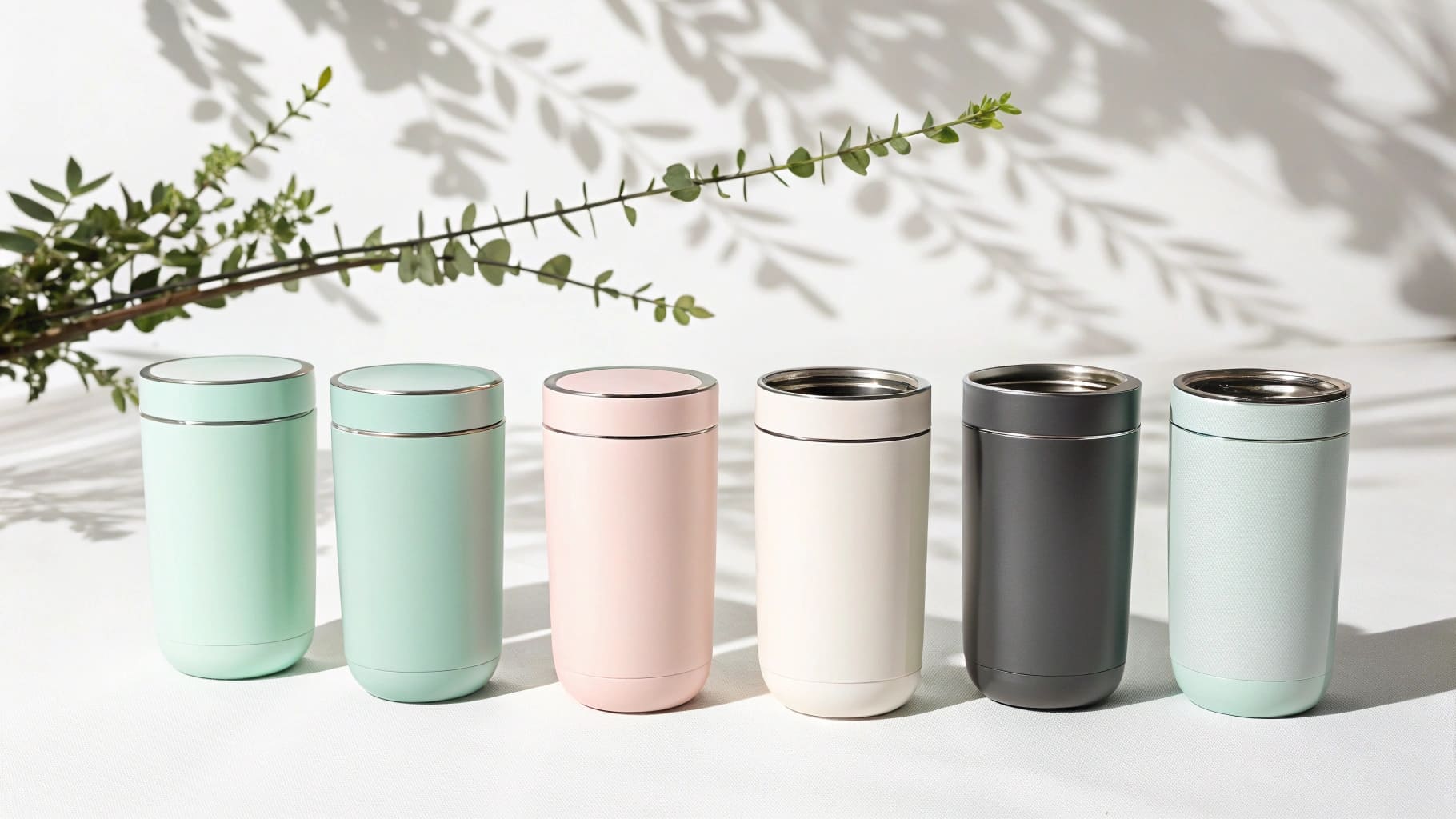Struggling to pick the right bottle material for your brand? It's a big choice. You want happy customers and a strong product line.
For most businesses, especially B2B, stainless steel water bottles are the top choice. They are safer, more versatile for different drinks, and very durable. This makes them a reliable option for importers and brand owners.

Choosing the right material for your reusable water bottles is a big decision. It affects your product's quality, how your customers see your brand, and your bottom line. As someone in the stainless steel drinkware business for years, I've seen trends come and go. I've also learned what truly matters for B2B clients like you. Let's look closely at copper and stainless steel. This will help you make a smart choice for your inventory. We want to make sure you pick a material that meets your customers' needs and helps your business grow.
Which is better copper or steel water bottles?
Are you wondering if copper or steel makes a better water bottle for your business? This choice impacts your brand's appeal and customer satisfaction.
Stainless steel bottles, particularly 304 or 316 grade, are generally better for B2B. They are non-reactive, safe for all drinks, durable, easy to clean, and cost-effective for customization. This makes them ideal for widespread use.

When I talk with procurement officers or startup owners, the conversation often turns to practicality and market appeal. For your business, you need a product that is reliable and has broad appeal. Let's break down why stainless steel often comes out on top for water bottles in a B2B context.
First, think about versatility. Stainless steel, especially food-grade 304 or 316, doesn't react with any beverage. Your customers can put water, juice, coffee, or even a fizzy drink in it. The taste will not change. This is a huge selling point. Copper, on the other hand, can react with acidic drinks. This can change the taste and is a concern for users.
Second, durability and maintenance. Stainless steel is tough. It resists dents and scratches well. It's also very easy to clean. Most are dishwasher safe. This is great for busy consumers. Copper bottles tarnish. They need regular polishing to look good. This is extra work for the end-user. As a business, offering low-maintenance products is a plus. I remember a client who initially considered copper. But the thought of customer complaints about tarnishing made them switch to stainless steel.
Third, customization and cost. Stainless steel is fantastic for branding. We at Icobottle easily customize these bottles with logos and different colors. The material is also cost-effective for large orders. This means better margins for you. Copper is generally more expensive as a raw material. This can make the final product pricier and might limit your market.
Here's a quick comparison:
| Feature | Stainless Steel (304/316) | Copper | B2B Implication |
|---|---|---|---|
| Reactivity | Non-reactive with drinks | Reacts with acidic liquids | Steel is safer and more versatile for all beverages. |
| Durability | High, resists dents & rust | Softer, can dent, tarnishes easily | Steel offers longer product life, less complaints. |
| Maintenance | Easy to clean, often dishwasher safe | Requires regular polishing | Steel is more convenient for the end-user. |
| Customization | Excellent for logos, colors | Possible, but material is pricier | Steel allows for better branding at a lower cost. |
| Cost | More cost-effective in bulk | Higher material cost | Steel offers better profit margins for wholesalers. |
| Taste | No metallic taste, preserves flavor | Can impart metallic taste, alter flavor | Steel ensures drink integrity. |
For B2B buyers, stainless steel bottles just offer a more robust, versatile, and commercially sound product. It’s about giving your customers a product they can trust and use every day without hassle.
Which is better, copper or steel?
Confused about whether copper or steel is fundamentally the superior material? Each has unique properties, but one usually fits better for business needs.
For water bottles and general B2B applications, stainless steel is often better. It provides an excellent balance of safety, durability, non-reactivity, and ease of customization, which are key for businesses.

When we compare copper and steel, we are looking at two very different metals. Their basic properties make them suitable for different things. As a B2B supplier, I always guide my clients to think about how these properties impact the final product and their business.
Let's look at stainless steel. The "stainless" part is key. It means it resists rust and corrosion very well. This is because it contains chromium, which forms a protective layer. For a water bottle, this means it will last a long time and stay hygienic. It's also very strong. This strength makes it great for everyday items that might get dropped or knocked around. From a business point of view, this means fewer returns and happier customers. Plus, steel is non-porous. So, it doesn’t harbor bacteria easily if cleaned properly. This is a big selling point for health-conscious consumers. We use 304 and 316 grade steel. These are top-quality food-grade options. They ensure no chemicals leach into the water.
Now, let's consider copper. Copper is known for being a great conductor of heat and electricity. This isn't a big advantage for a water bottle, unless it's a specific type of insulated design, which is rare for pure copper bottles. Copper is also naturally antimicrobial. This means it can kill some bacteria on its surface. This sounds good. But, for a water bottle, the inside needs to be safe for all liquids. The antimicrobial benefit might be limited if the bottle isn't cared for properly or if it has a lining. It's also a softer metal than steel. So, it can dent more easily. I recall a buyer who was interested in copper's unique look. However, after discussing the practical side – potential dents, tarnishing, and shipping concerns for a softer material – they realized stainless steel was a safer bet for large volume orders.
Here’s how their core properties stack up for products like bottles:
| Property | Stainless Steel | Copper | Implication for B2B Water Bottles |
|---|---|---|---|
| Corrosion Resistance | Excellent | Prone to tarnishing/patina, can corrode | Steel maintains appearance and integrity longer. |
| Strength/Hardness | High | Relatively soft, malleable | Steel is more resistant to dents and damage. |
| Hygiene | Non-porous, easy to sterilize | Antimicrobial surface, but needs cleaning | Steel is generally easier to maintain for hygiene. |
| Non-Reactivity | Excellent with food/drinks (food-grade) | Can react with acidic substances | Steel is safer for a wider range of beverages. |
| Thermal Conductivity | Lower (good for insulation with double walls) | High | Steel is better for insulated bottle designs. |
Ultimately, for businesses selling reusable drinkware, stainless steel's robust and neutral characteristics usually make it the more practical and reliable choice. It supports a quality brand image effectively.
What are the negatives of copper water bottles?
Are you considering copper bottles but worried about hidden downsides? Understanding the negatives is key before investing your business capital.
The main negatives of copper water bottles include reacting with acidic drinks, potentially leading to excessive copper intake, and tarnishing easily, requiring frequent maintenance from users.

While copper water bottles have a certain aesthetic appeal and some traditional health claims, it's crucial for businesses to understand their potential drawbacks. These negatives can impact customer satisfaction and your brand's reputation. I've had many discussions with clients about these points.
The biggest concern is reactivity. Copper is a reactive metal. If your customer puts acidic drinks like fruit juice, coffee, or even lemon water into a pure copper bottle, the copper can leach into the drink. This not only gives an unpleasant metallic taste but can also lead to consuming too much copper. While our bodies need a small amount of copper, too much can be harmful. This is a serious safety consideration. As a B2B seller, you don't want to be responsible for potential health issues or even just taste complaints. This was a deal-breaker for one of my clients who wanted to target the health and wellness market. The risk of negative reactions was too high.
Another significant negative is maintenance. Copper tarnishes. It develops a patina over time due to oxidation. Some people like this look, but many prefer a shiny bottle. To keep it shiny, the bottle needs regular polishing with special cleaners. This is extra effort for the consumer. If they don't maintain it, the bottle can look dull or stained. This might lead to disappointment with the product. Stainless steel, in contrast, is very low maintenance. A simple wash is usually enough.
Then there's the cost and durability. Copper is generally more expensive than stainless steel. This higher material cost translates to a higher product price, which might narrow your customer base. Also, copper is a softer metal. Copper bottles can dent and scratch more easily than stainless steel ones. This impacts the perceived quality and longevity of the product.
Finally, consider the niche market. While some consumers are specifically looking for copper bottles due to perceived Ayurvedic benefits, it's a smaller market segment compared to the broad appeal of stainless steel. For businesses aiming for volume sales and wide market penetration, stainless steel is often the more strategic choice.
Let’s list these negatives clearly:
| Negative Aspect | Description | B2B Implication |
|---|---|---|
| Reactivity with Acids | Leaches copper into acidic drinks (juice, coffee, lemon water). Alters taste. | Potential health concerns for users, taste complaints, limited drink use. |
| Excessive Copper Intake | Risk of consuming too much copper if leaching occurs regularly. | Serious health liability, damage to brand trust. |
| Tarnishing | Oxidizes and loses shine, requires frequent polishing. | Higher maintenance for users, can lead to dissatisfaction with appearance. |
| Softer Material | More prone to dents and scratches compared to stainless steel. | Lower perceived durability, potential for damage during shipping or use. |
| Higher Cost | Copper as a raw material is often more expensive. | Higher product price, potentially smaller target market, lower profit margins. |
| Taste Alteration | Can impart a metallic taste even to water for sensitive individuals. | Negative user experience, may not be suitable for all users. |
For my B2B clients at Icobottle, I almost always recommend stainless steel. It avoids these headaches and provides a reliable, high-quality product that appeals to a broad audience.
Conclusion
In short, for B2B, stainless steel bottles usually offer better safety, versatility, and value. This makes them a smarter choice for your business success.

